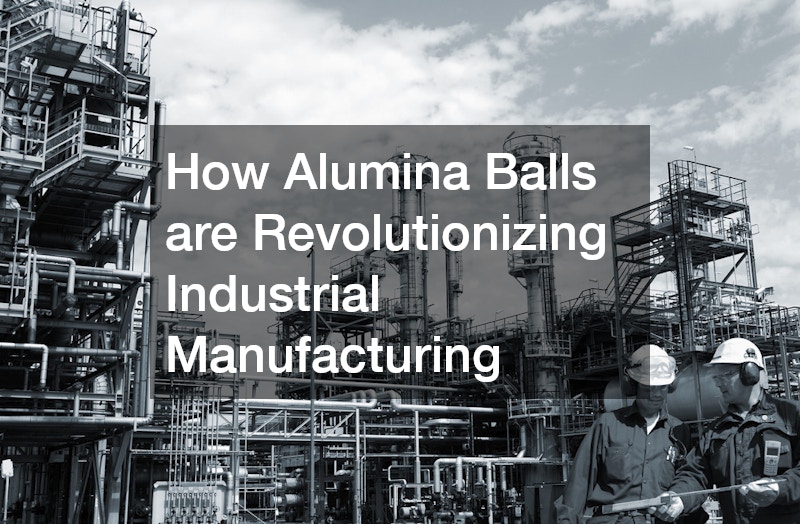In the fast-paced world of industrial manufacturing, materials that can withstand extreme conditions while improving efficiency are invaluable. Among these, alumina balls have emerged as a game-changing component, transforming processes across various sectors. Their unique properties, such as high thermal stability, chemical inertness, and exceptional mechanical strength, make them ideal for applications that demand durability and performance. This blog will explore how alumina balls are revolutionizing industrial manufacturing by enhancing process efficiency, improving product quality, and supporting sustainable operations.
The Unique Properties of Alumina Balls
Alumina balls are made from aluminum oxide, a ceramic material known for its hardness and resistance to heat and corrosion. These small spherical pellets are engineered to maintain integrity under harsh conditions, which is why they have become indispensable in industries ranging from petrochemical to pharmaceuticals.
One of the key characteristics that set alumina balls apart is their excellent thermal resistance. They can withstand temperatures far beyond what many metals or plastics tolerate, making them suitable for high-temperature reactors and kilns. Their chemical inertness means they do not react with most substances they come into contact with, preserving product purity and preventing contamination.
Additionally, alumina balls exhibit remarkable mechanical strength and wear resistance. This durability allows them to endure constant mechanical stress in applications like grinding mills, where abrasive forces are common. These combined properties ensure alumina balls contribute to longer-lasting, more reliable industrial systems.
Enhancing Process Efficiency
Efficiency is a top priority in manufacturing, and alumina balls play a vital role in optimizing various processes. For example, in catalytic reactors, alumina balls serve as an excellent catalyst support. Their spherical shape and porosity provide a large surface area, facilitating better catalyst dispersion and increasing the contact between reactants and the catalyst.
This improved contact accelerates chemical reactions, boosting production rates and reducing energy consumption. In turn, this means manufacturers can achieve higher throughput with lower operational costs. The consistent quality and shape of alumina balls also ensure uniform flow dynamics within reactors, preventing issues like channeling and dead zones that can reduce efficiency.
In grinding applications, alumina balls function as grinding media in ball mills, where they crush and pulverize raw materials into finer particles. Their hardness reduces contamination risks and prevents premature wear, leading to more efficient milling operations and better product consistency.
Improving Product Quality and Consistency
Maintaining high product quality is crucial across industries, and alumina balls contribute significantly to this goal. Their chemical inertness ensures they do not introduce impurities during manufacturing processes, which is essential in sectors like pharmaceuticals and food production.
Moreover, the uniform size and density of alumina balls help maintain steady process conditions. This consistency results in predictable and reproducible product characteristics, which manufacturers strive to achieve. For example, in catalytic cracking units in oil refineries, alumina balls maintain stable temperature profiles and pressure conditions, leading to better control over product output.
Their wear resistance also means that alumina balls maintain their shape and size over extended use, preventing fluctuations in processing conditions that could affect product quality.
Supporting Sustainable Manufacturing Practices
Sustainability is becoming increasingly important in industrial manufacturing, and alumina balls support this shift by contributing to energy efficiency and waste reduction. Their ability to enhance catalytic reactions reduces the amount of raw materials and energy required for production.
Furthermore, alumina balls’ durability translates to longer equipment life and reduced downtime, decreasing waste from frequent replacements and repairs. Their inert nature also minimizes the need for additional chemical treatments or cleaning agents, which can be harmful to the environment.
By improving process efficiency and product quality, alumina balls help manufacturers meet environmental regulations and sustainability goals without compromising productivity.
Versatility Across Industries
The benefits of alumina balls are not limited to a single sector. They have found applications in petrochemical refining, chemical manufacturing, ceramics production, pharmaceuticals, and even environmental engineering.
In petrochemical plants, alumina balls support catalysts used in processes like hydrocracking and catalytic reforming, essential for producing fuels and chemicals. In the pharmaceutical industry, their inertness and purity make them ideal for grinding active ingredients without contamination.
Environmental applications include their use in gas absorption towers, where alumina balls improve the efficiency of pollutant removal by providing a large surface area for chemical interactions.
This versatility makes alumina balls a valuable material for manufacturers looking to innovate and upgrade their operations.
Alumina balls are truly revolutionizing industrial manufacturing by offering a combination of durability, efficiency, and versatility that few other materials can match. Their unique properties enable improved process efficiency, higher product quality, and more sustainable manufacturing practices. As industries continue to demand better performance and environmental responsibility, the role of alumina balls will only grow in significance.
By integrating alumina balls into their operations, manufacturers can stay ahead of the curve, optimizing production and reducing costs while meeting modern standards for sustainability and quality. Whether in refining, pharmaceuticals, or environmental engineering, alumina balls are proving to be indispensable tools in the ongoing evolution of industrial manufacturing.



